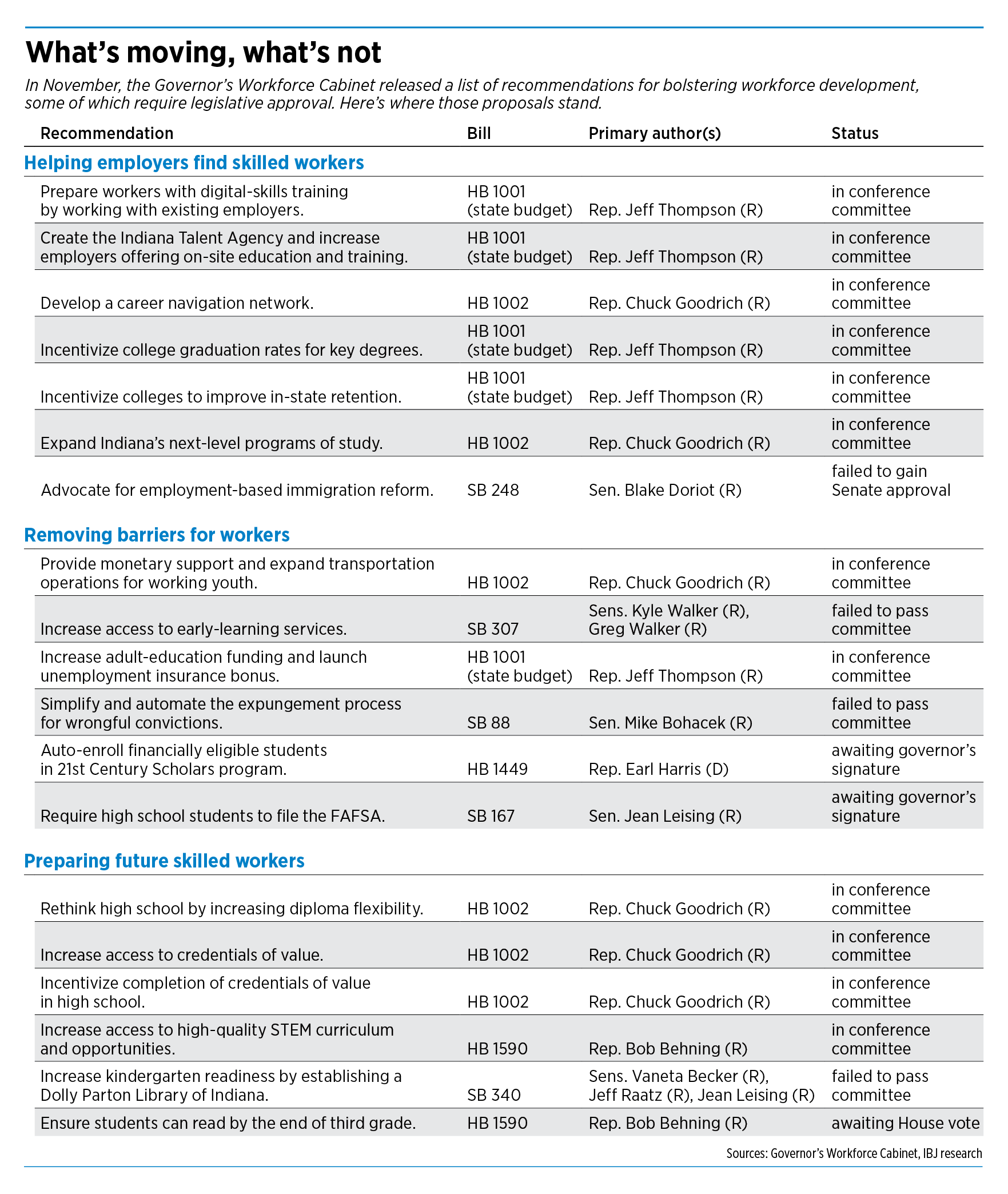Ricky Sanchez’s path to a stable career has been anything but conventional.
After doing ministry work in Oklahoma and Texas for more than a decade, the 40-year-old California native and his wife, a nurse, moved with their three boys to Indiana in 2019 to be closer to their grandparents. Sanchez looked for work, but because he dropped out of school in 10th grade, his options were limited.
He found a way forward at Bloomington-based Cook Medical, a medical-device manufacturer that offers an innovative program called My Cook Pathway. It allows employees to earn their GED certificate or bachelor’s degree while working for the company.
Sanchez received a full-time salary while doing part-time work and taking classes and, in three months, earned his high-school-equivalency diploma. Cook then offered him a full-time job manufacturing dilators.
“That was the first time I really accomplished something for myself,” Sanchez recalled. “It was cool to push myself and show the boys that it’s never too late to push yourself to get out of your comfort zone and get things done.”
Sanchez’s story is just one example of how employers are playing a more active role in the lives of their employees. But not every employer has the same resources as Cook Medical, whose parent company, Cook Group Inc., is one of Indiana’s 20 largest employers.
So employers, lawmakers and business leaders have banded together to craft legislation that encourages people to stay in high school and pursue postsecondary education or to revisit educational opportunities later in life and find a more direct route to a successful career. Some bills even reimagine high school by offering more pathways to graduation and job placement.
But in the closing weeks of this year’s Indiana General Assembly, they are having difficulty agreeing on the most effective ways to fill the state’s workforce needs. The primary goals are boosting the state’s high school graduation rate above the national average, increasing the percentage of Hoosiers with post-high-school education and developing the trained workers needed to fill job gaps created by the retirement of baby boomers.
 Chuck Goodrich
Much of the debate is focused on House Bill 1002, authored by Rep. Chuck Goodrich, R-Noblesville, whose company, Gaylor Electric, has a partnership with The Crossing School of Business and Entrepreneurship in Noblesville. The private high school offers career and technical education, along with work-based learning experiences.As it was introduced, HB 1002 would have created state-funded career scholarship accounts students could use toward technical coursework and credentials based on their career aspirations and interests.
Chuck Goodrich
Much of the debate is focused on House Bill 1002, authored by Rep. Chuck Goodrich, R-Noblesville, whose company, Gaylor Electric, has a partnership with The Crossing School of Business and Entrepreneurship in Noblesville. The private high school offers career and technical education, along with work-based learning experiences.As it was introduced, HB 1002 would have created state-funded career scholarship accounts students could use toward technical coursework and credentials based on their career aspirations and interests.
Goodrich proposed giving $2,500 to $5,000 students who chose to participate in workforce training, with lawmakers hoping to get 5,000 to 10,000 students in the program by the next fiscal year.
But the Senate amended the bill, eliminating the career scholarship accounts as well as a controversial requirement that every high school student meet with a career adviser for 30 minutes, which some lawmakers and educators saw as problematic and cumbersome.
Instead of individual career accounts, the Senate version of the bill creates a career advising grant program fund that would go toward state-approved “intermediary” organizations that serve as the link between schools and employers.
 Jeff Raatz
Jeff Raatz
Intermediaries can include workforce development boards—like EmployIndy, the Marion County workforce board—as well as industry trade groups such as the Indiana Manufacturers Association.
“One of my dreams is to give every student a career adviser to help them know about themselves and the pathway they may have,” said Sen. Jeff Raatz (R-Richmond), Senate Education Committee chair and the Senate sponsor for the bill.
How much funding will be allocated to either career scholarship accounts or the career advising fund will be decided next week in conference committee, where two House members and two senators are appointed to reconcile differences. Any legislation that requires funding also will be subject to change as part of negotiations on House Bill 1001, the biennial state budget.
Lawmakers face an April 29 deadline to finish their business for the year.
 Jason Bearce
Jason Bearce
“Both the House and Senate recognize that there’s an opportunity to provide more support and guidance to students,” said Jason Bearce, vice president of education and workforce development for the Indiana Chamber of Commerce, which supported the Senate amendments.
“Indiana stacks up really well in terms of business climate. Where we don’t stack up well relative to our peers is the educational skill level of our working-age populations, so any opportunity to give students more real-world experiential learning options is a great thing.”
One particularly troubling development is that only 53% of Hoosier high school graduates from the class of 2020 went on to pursue postsecondary education, down from 65% in 2015, according to a June report from the Indiana Commission for Higher Education.
The House and Senate also are at odds over how much funding should be allocated to the Governor's Workforce Cabinet, a group formed in 2018 with the mission of addressing education and employment needs for Hoosiers and employers. The House budget included $16 million for the cabinet; the Senate version cut that roughly in half.
Senate Appropriations Chair Ryan Mishler, R-Mishawaka, said the Senate opted for the cut after failing to get answers as to how the cabinet would use the funding. “They’re gonna have to justify what they’re gonna use their money for,” Mishler said Wednesday.

In November, the cabinet released a list of more than two dozen recommendations for bolstering workforce development, some of which require legislation.
Some school administrators would like to see funding for career scholarship accounts reinstated in HB 1002.
 Ryan Hill
Ryan Hill
“I do support the incentive structure and really wish that would go back in,” said Ryan Hill, CEO of The Crossing School. “I think the CSA accounts and those types of programs—it’s going to take those innovative ideas to really make this happen as a state.”
But groups such as the Indiana State Teachers Association, the state’s largest union representing public school teachers; the Indiana Coalition for Public Education; and the American Federation of Teachers of Indiana opposed the concept.
ISTA lobbyist John O’Neal told House members during testimony on the bill that the CSA program “takes these work-based learning programs in a different direction and raises too many unanswered questions, at this point, regarding the education of these students.”
Rather than adding more programs, Indiana should do more to support existing career technical education programs, O’Neal said. “We should do more with CTE programs that have been in schools for years, not working against them.”
But some lawmakers don’t believe existing programs are doing enough.
“The world is changing at a rapid pace,” Goodrich said. “We need to ensure that our students are ready for all that lies beyond high school.”